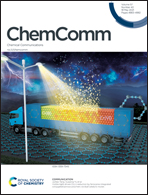The kinetics and mechanism of interconversion within a system of [Fe2L3]4+ helicates and [Fe4L6]8+ cages†
Abstract
Nature builds simple molecules into highly complex assemblies, which are involved in all fundamental processes of life. Some of the most intriguing biological assemblies are those that can be precisely reconfigured to achieve different functions using the same building blocks. Understanding the reconfiguration of synthetic self-assembled systems will allow us to better understand the complexity of proteins and design useful artificial chemical systems. Here we have prepared a relatively simple system in which two distinct self-assembled structures, a [Fe2L3]4+ helicate and a [Fe4L6]8+ cage that are formed from the same precursors, coexist at equilibrium. We have measured the rates of interconversion of these two species and propose a mechanism for the transformation.
![Graphical abstract: The kinetics and mechanism of interconversion within a system of [Fe2L3]4+ helicates and [Fe4L6]8+ cages](/en/Image/Get?imageInfo.ImageType=GA&imageInfo.ImageIdentifier.ManuscriptID=D1CC01583D&imageInfo.ImageIdentifier.Year=2021)


 Please wait while we load your content...
Please wait while we load your content...